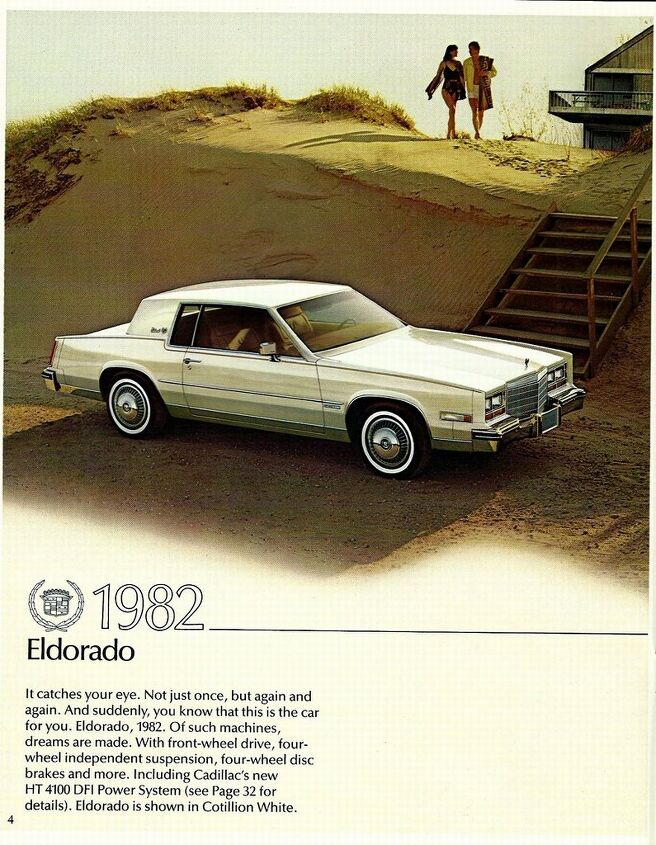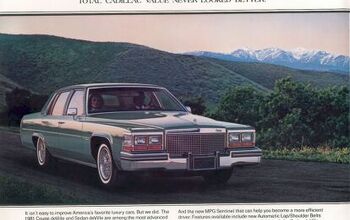Abandoned History: General Motors' High Technology Engine, and Other CAFE Foibles (Part II)

In our last edition of Abandoned History, we covered the years leading up to the release of the Cadillac High Technology V8. Used almost exclusively in 1981, the disastrous V8-6-4 had a primitive engine management system that could deactivate either two or four cylinders on Cadillac’s traditional V8. And while the idea was sound, the technology and engineering behind it were not. Cadillac was left in a bind and needed a replacement engine immediately. But the engine of choice was not finished, and not ready for primetime. Ladies and gentlemen, welcome the medium-rare HT4100.
As mentioned last time, the HT was supposed to debut on front-drive Cadillacs in 1983. However after V8-6-4 was a flop, HT was applied to the marque’s existing lineup in 1982. That meant HT was pushed through its latter development stages at a breakneck pace and shoved into production far earlier than The General planned.
Coded as LT8, the new High Technology engine was considerably smaller and lighter than the 368 cubic-inch (6.0L) V8 it replaced. Known by its metric displacement, the 4.1 was not known by its 249 cubic inches. That old-school measurement was headed well into the sunset by the early Eighties. The HT could be applied to rear- or front-wheel drive Cadillacs. For marketing and luxury reasons, the HT engine was exclusive to Cadillac vehicles. Non-Cadillacs had to make do with less technologically prestigious engines.
One thing HT V8 Cadillacs shared with other GM offerings was the transmission bell housing, which was the same pattern as on front- and rear-drive Pontiac, Buick, and Oldsmobile passenger cars. This was especially relevant for parts sharing purposes, and the upcoming front-drive Cadillac models were due for debut in 1983. But as the HT was put into production early, conversely the front-drive Cadillacs and their siblings were delayed. The downsizing project at GM had continual difficulties, while everyone worked under incorrect analysis that stated fuel prices would soar by 1985.
Front-drive Cadillacs were ready for the 1985 model year, to the general chagrin of just about everyone. The HT4100-equipped Cadillacs were too small, too ugly, less appealing with front-drive, and again too small. Lincoln skewered GM’s downsizing with its proud full-size cars that still came with length. The predicted fuel price spike didn’t happen, and customers across Cadillac, Oldsmobile, and Buick turned to larger luxury rivals instead. General Motors spent the next seven model years fixing its downsized front-drive Cadillacs. About that time the Northstar arrived (uh oh) and its traditional customer stopped driving altogether. But that’s a story for another day. Back to HT.
In 1982 Cadillac implemented their new engine across the entire line, except for the all-new Cavalier-based Cimarron (where it wouldn’t fit) and the Fleetwood factory limousine, which kept the 368 V8 through its end in 1984. Customers of the DeVille, Seville, Eldorado, and Fleetwood Brougham found much more empty space in their engine bays should they have taken a peek. Where it applied, the 4.1 HT was standard equipment, while a 4.1-liter V6 was a credit option, and the diesel V8 cost extra. Later join-ins to the HT party included the new front-drive C-body Fleetwood of 1985 and the Allante halo convertible in 1987.
The modern electronic control module that GM invented on the V8-6-4 was refined and became an important part of the new HT engine. It still worked similarly as it had in the 368 V8, and monitored engine performance via an onboard diagnostic system. As before, information from the ECU was displayed directly on the climate control panel, while the car was running. No attempt at cylinder deactivation programming was made. Elsewhere General Motors played it a bit more traditional, and opted for throttle-body fuel injection instead of multiport. The 4.1 managed 135 modern horsepower, and 190 lb-ft of torque.
The TBI was joined by a higher running temperature, which meant the engine burned more cleanly and had better emissions. Other modern engine advancements included mixed metal construction: Durable cast-iron heads were attached to a lighter-weight aluminum block. The cylinder sleeves were replaceable. Life-giving coolant circulated between the engine block and heads freely, rushing past the various sturdy surfaces of the engine’s interior.
Problems were almost immediately apparent. Issues started with the block itself, as the HT4100 experienced faults quite similar to its Northstar successor a decade later: The bolts pulled loose from the aluminum block and took the threads with them. That wasn’t the only concern with the block itself. It seemed the rushed production schedule on the HT showed up in quality control issues like weak engine block castings.
Outside the block, the HT4100 often experienced intake manifold gasket failure as two different metals rubbed against one another. Aluminum was used in other high-stress areas too. The HT4100’s oil pump was made of the stuff and often failed. Camshaft bearings failed too and spun themselves into oblivion.
Customers weren’t pleased with the HT4100 given all its problems, but the engine was still an improvement over the V8-6-4 that pinged itself away in their ’81 Cadillacs. It was also much better than the simply terrible 5.7-liter Diesel offered via Oldsmobile. The HT4100 earned a bad reputation almost instantly for all the reasons cited above, even though Cadillac still sold a huge number of cars at the time. In 1981 230,665 people bought Cadillacs, most of which were equipped with the V8-6-4. That infamous engine was well-known as customers went back in 1982 and increased Cadillac’s sales to 249,295. Sales increased under HT4100’s tenure too, cresting just over 300,000 in 1983, and on to 320,027 in 1984. Buyers were loyal and simply had to have that Cadillac Style.
The final development of the HT4100 arrived in 1987, as the engine was finally added to the eagerly awaited, disastrous, and very expensive Allante. For a customer’s $54,000 ($135,389 adj.) in 1987, they received a most special version of the 4.1-liter in their front-drive and Pininfarina-designed convertible. Inside the engine used a revised camshaft profile, and hydraulic roller-style lifters. Both revisions helped to improve airflow and increased the 4.1’s horsepower figure significantly over the standard engine. Power reached 170 horses (from 135), and torque was 235 lb-ft. This version of the HT was exclusive to Allante and produced for only two years.
Before we go any further with the HT, we need to take a quick sidebar into a GM engine spawned entirely by emissions regulations: the Oldsmobile diesel. Through its various versions, it was always bad but didn’t have to be. Its issues stemmed from a rushed development timeline and the continual cost-cutting of GM accountants. Until next time.
[Images: GM]

Interested in lots of cars and their various historical contexts. Started writing articles for TTAC in late 2016, when my first posts were QOTDs. From there I started a few new series like Rare Rides, Buy/Drive/Burn, Abandoned History, and most recently Rare Rides Icons. Operating from a home base in Cincinnati, Ohio, a relative auto journalist dead zone. Many of my articles are prompted by something I'll see on social media that sparks my interest and causes me to research. Finding articles and information from the early days of the internet and beyond that covers the little details lost to time: trim packages, color and wheel choices, interior fabrics. Beyond those, I'm fascinated by automotive industry experiments, both failures and successes. Lately I've taken an interest in AI, and generating "what if" type images for car models long dead. Reincarnating a modern Toyota Paseo, Lincoln Mark IX, or Isuzu Trooper through a text prompt is fun. Fun to post them on Twitter too, and watch people overreact. To that end, the social media I use most is Twitter, @CoreyLewis86. I also contribute pieces for Forbes Wheels and Forbes Home.
More by Corey Lewis
Latest Car Reviews
Read moreLatest Product Reviews
Read moreRecent Comments
- Lorenzo The Longshoreman/philosopher Eri Hoffer postulated "Every great cause begins as a movement, becomes a business, and ends up as a racket." That pretty much describes the progression of the United Auto Workers since World War II, so if THEY are the union, the answer is 'no'.
- Redapple2 I think I ve been in 100 plants. ~ 20 in Mexico. ~10 Europe. Balance usa. About 1/2 nonunion. I supervised UAW skilled trades guys at GM Powertrain for 6 years. I know the answer.PS- you do know GM products - sales weighted - average about 40% USA-Canada Content.
- Jrhurren Unions and ownership need to work towards the common good together. Shawn Fain is a clown who would love to drive the companies out of business (or offshored) just to claim victory.
- Redapple2 Tadge will be replaced with a girl. Even thought -today- only 13% of engineer -newly granted BS are female. So, a Tadge level job takes ~~ 25 yrs of experience, I d look at % in 2000. I d bet it was lower. Not higher. 10%. (You cannot believe what % of top jobs at gm are women. @ 10%. Jeez.)
- Redapple2 .....styling has moved into [s]exotic car territory[/s] tortured over done origami land. There; I fixed it. C 7 is best looking.









































Comments
Join the conversation
Eleven years ago I bought a then 10-year old Lexus. For giggles when I was shopping, I looked at a couple same year Caddys. I said I did that for giggles, right?
The old man had a 8-6-4 engine in his (1981?) Cadillac. It was actually a nice V8, provided you bypasses the 8-6-4 computer and kept it in permanent 8 mode. My uncle, as a side note, designed the machinery that made the engine bits. Tool 'n' Die guy for years.